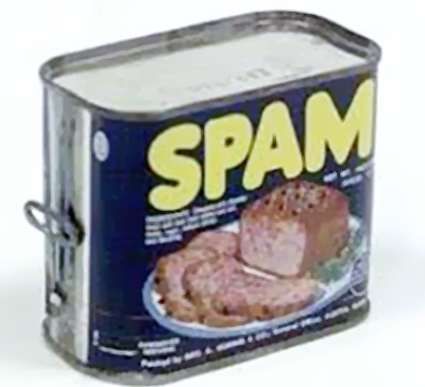I do, however, remember two leftovers from rationing that persisted into subsequent years. The first is the zinc-coated steel penny minted in 1943 to conserve copper, which was needed for ammunition and other military equipment. These pennies were lighter in weight than their copper counterparts, and unlike any other American coin ever, they were magnetic. They continued to turn up like - well, like a bad penny - until the 1960s, when the Mint finally succeeded in collecting and destroying most of them. They can now be purchased for a few dollars apiece; only a handful of 1943 copper pennies and 1944 steel pennies, both struck by accident, have any real value.
Spam is a canned cooked meat product with an almost indefinite shelf life (claims the manufacturer; or 2-5 years if you go by its “best by” date), made with pork, ham, salt, water, modified potato starch, sugar, and sodium nitrate. Natural gelatin is formed during cooking and leaves a jelly-like coating in the can. One 3.5oz serving is laden with enough salt (57% of what you should eat every day), fat (41%), and preservatives to make a nutritionist cringe. On the other hand, it has only six ingredients (not counting water), none of them unpronounceable, bringing it close to complying with the "five-ingredient rule" - Michael Pollan's famous criterion for "real food."
Born of the Depression, Spam was introduced in 1937 by the Hormel Foods Corporation of Austin, Minnesota. The name was invented by the brother of a Hormel executive, who won a $100 prize for his submission. Hormel claims that it means something, but exactly what is a closely-guarded secret (perhaps forgotten by now). Speculations include that it is an abbreviation or acronym for "spiced ham", "spare meat", "shoulders of pork and ham”, “Specially Processed American Meat”, “Specially Processed Army Meat”, and a large number of less printable variants.
Although Spam had already been around for a few years, it was during the War that it became a staple of the American diet - because unlike most other meat products it was not rationed. Because of the difficulty of getting fresh meat to the Front, it was also ubiquitous in the military, serving as the WWII version of MRE. The Army found other uses for Spam as well - to grease guns, for example - and the cans were used for scrap metal. Consequently, the majority of Americans old enough to qualify for Medicare probably remember eating Spam. (And like me, they probably remember the distinctive can that opened with a key.)
My mother, true to her New England roots, served it pan-fried with baked beans. I don't know that I ever clamored for it, but I really don't remember it as a penance, either.
Over the years, Spam has taken its place in popular culture, turning up thinly disguised in Mr. Blandings Builds His Dream House (in which Cary Grant, who works for an ad agency, is assigned to the "Wham" account); in 'Weird Al' Yankovic's take-off on the R.E.M. tune "Stand"; as well as in many more obscure locations.
But by far the best-known parody of Spam is an iconic 1970 Monty Python skit in which the server in a cafe offers “her” customers “Spam, Spam, Spam, egg and Spam; Spam, Spam, Spam, Spam, Spam, baked beans, Spam, Spam, Spam, or Lobster Thermidor aux crevettes with a Mornay sauce served in a Provencale manner with shallots and aubergines garnished with truffle pate, brandy, and with a fried egg on top and Spam." Meanwhile, a group of Vikings who also happen to be eating in the cafe (where else would a Spam-craving Viking hang his horned helmet?) periodically bursts into song in exuberant praise of "Spam, Spam, Spam, Spam, Spammity Spam, Wonderful Spam." It would probably be safe to say that the Monty Python sketch is more famous than Spam itself, and that except for the oldest among us, many would never otherwise have heard of Spam. The source for the use of the term "spam" to refer to unsolicited and unwanted email is almost certainly Monty Python and not Hormel.
Is there a connection between spam and Spam, beyond the fact that both are something you might prefer not to appear on your plate? The answer appears to be no. Since the information technology world was (and is) populated by Monty Python fans, the simultaneous appearance of the Spam skit about mystery meat and the felt need for a term for mystery email seems to have been pure serendipity. If anyone has a better answer to this question please let me know!
Will Spam ever make a comeback? Can its humble image be polished? After I learned that some chichi Manhattan restaurants added dishes with tobacco as an ingredient to their dessert menus when indoor smoking was banned, nothing would surprise me. Accordingly, I googled "spam served in fancy restaurants" and sure enough, up (among several entries) popped a 2015 blog post entitled "SPAMalot! Look at How These Trendy Chefs Are Using Spam," featuring such multi-ethnic entrees as Spam Sliders, Spam Sushi Dog, and (in a pairing that startled even jaded diners-out) Foie Gras and Spam Loco Moco.
Shades of Monty Python.




 RSS Feed
RSS Feed